One of the many enhanced features of StatsBomb Data is pass footedness. Today we’re going to look at some results from looking at this feature of the data and show how pass footedness manifests within the Premier League. Footedness has historically been a feature that has been added to shot data and not passes, but shot volumes are small, and genuine clues around footedness can be concealed by player style or availability or opportunity; for example a centre back who finds the ball at their feet in their opponents six yard box will likely swing whatever boot is nearest to generate a shot. Back in their own half comfortable in possession, they are more likely to make a conscious choice as to which foot they pass with. Already we have a more detailed cut to look at player preferences.
Right: since this is new, let’s get some simple facts out of the way.
- There are an average of 870 passes in a 2018-19 Premier League game.
- Of those passes, around two thirds are made with a player’s right foot.
- Of the players, around three quarters are dominantly right footed.
- Right footed players average around 87% of their passes with their dominant foot, left footed players around 85%.
- On average, right footed passes are one metre longer than left footed passes.
- Right footed passes are completed around 81% of the time, left footed passes 78.5%. This trend holds regardless of the foot dominance of players.
- The difference between left footed players completion rates for their left foot (78.3%) and right foot (81.2%) is slightly larger than that of right footed players: left foot (78.6%) and right foot (80.9%).
- These trends all generally hold if you shrink the width of the pitch to the width of the penalty box, which was my idea of how to minimise the effect of full backs and wide players versus the touchline.
These are just counted stats, modelling work would no doubt start to highlight confounding factors but it’s interesting to see nonetheless.
We can see trends towards fewer left footed passes being completed across the pitch:
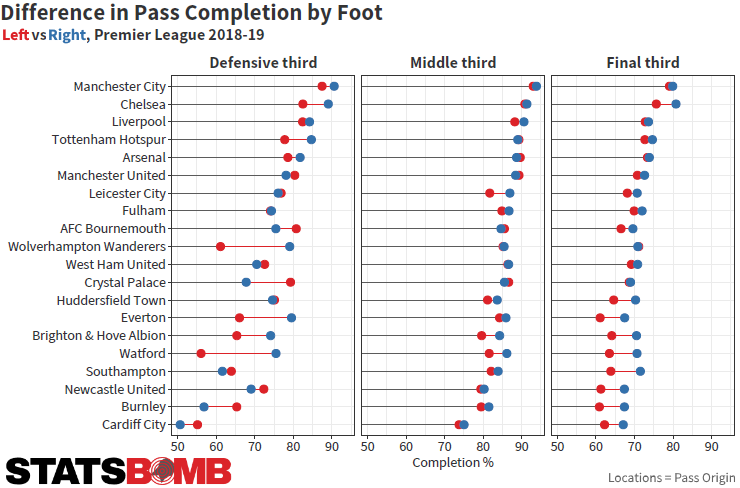
Here we see a fascinating signifier, every team in the Premier League bar one, Wolves, completes passes in the final third at a higher percentage with the right foot than left.
Team Breakdowns
Most teams will have a minimum of one left footed player--their left full back--but usually more. We can contrast opposites in the Premier League by looking at the two teams that attempt more passes than any other teams: Chelsea and Manchester City.
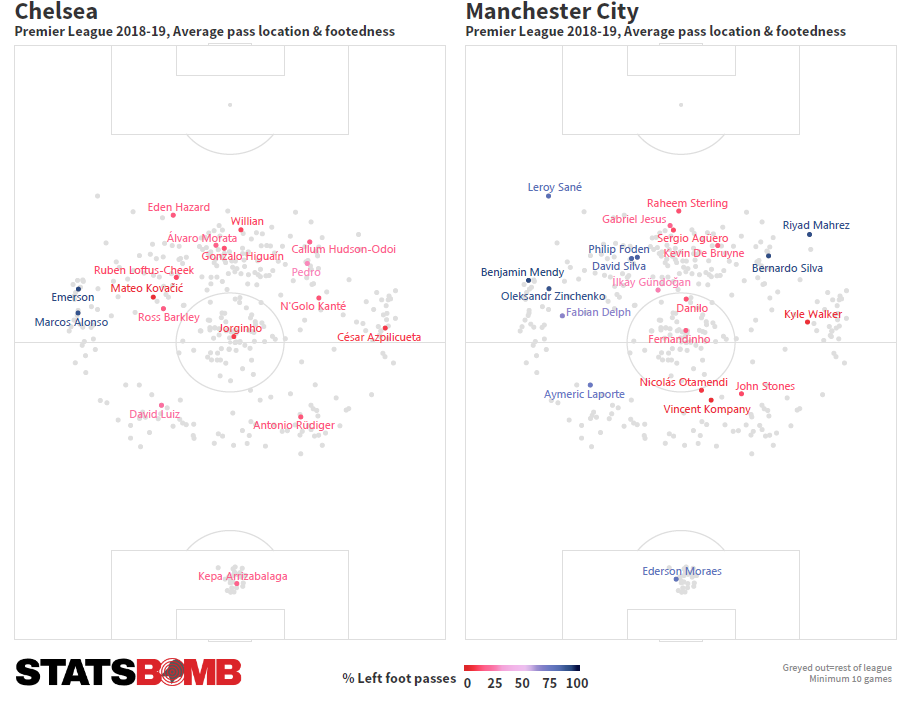
Even allowing for the effect of positional switches, a season long overview gives fairly strong indicators of player location and team structures and tendencies.
Of Chelsea players to have appeared in ten or more games, only their two left backs can be considered to be left footed. Pedro is the only attacker to approach two-footedness from a passing perspective and his Left/Right split is 27%:73%. Manchester City’s squad is chock full of left footed enterprise, with centre back Aymeric Laporte, converted midfielder-cum-full back Fabian Delph (who with a 35%:65% split would actually be a top three in the league two footed player, but lacks minutes, more on this later), Benjamin Mendy and Oleksandr Zinchenko all nominally part of the defensive corps, while David Silva and Phil Foden patrol midfield and Riyad Mahrez and Bernardo Silva usually occupy the right-to left orientated location so many left footed attacking players now do. Even keeper Ederson is left footed.
The example of Man City is extreme, but it’s notable that five of ten high priced outfielders they have signed since the summer of 2016 are left footed, including the one player we’ve omitted so far: Leroy Sané. As a left footed, left sided forward, Sané is legitimately unique in the Premier League:
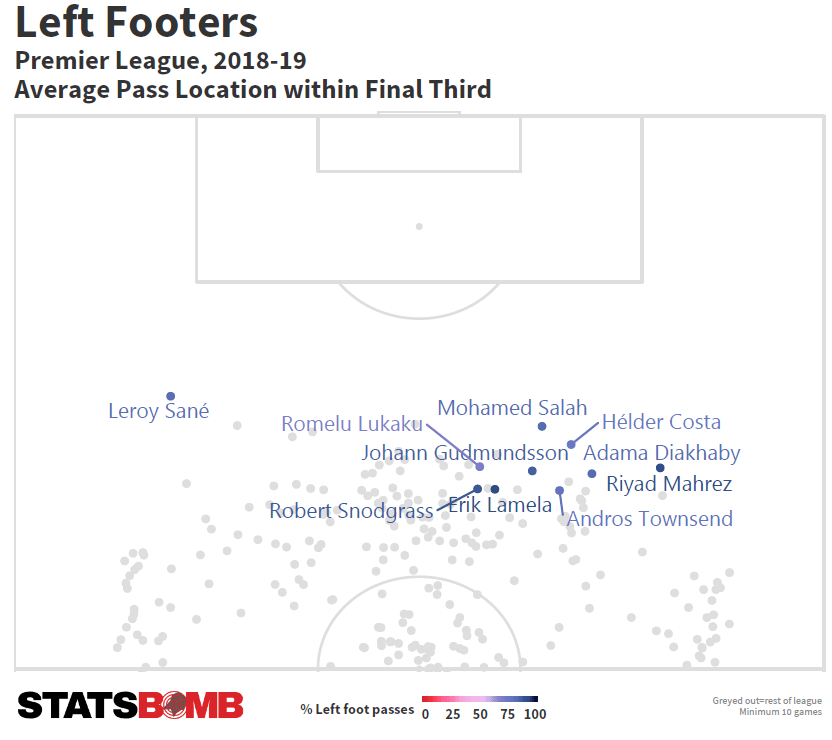
That chart shows every left footed player (minimum 10 games) who has an average pass location within the final third, and the chart for 2017-18 shows the same trend. Not only are Sané’s pass locations on the other side of the pitch to all his inverted lefty compadres, but his passes are recorded higher up the pitch than any other player in the league. Raheem Sterling may have acquired the starting left forward role for Manchester City in recent months, but Sané remains a useful and different attacking weapon.
Two footed players
Part of the motivation to look at this was the search for that most elusive of player: a two footed genius, for which every pass is a decision made by the unconscious mind and for whom the balance of footedness is entirely natural. To my surprise, it turns out that idyllic vision is inhabited currently by just one player in the Premier League, Cardiff’s Harry Arter:
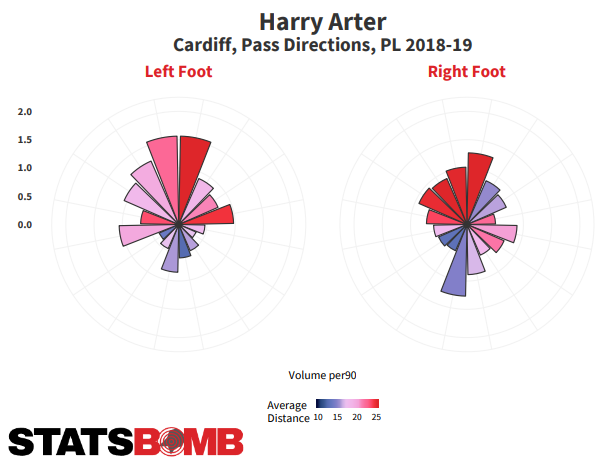
Credit @etmckinley for the viz concept
We’ll see some different scales on these as we go along so stay alert, but here we can see that although Arter doesn’t make a ton of passes (around 25 per 90), there’s a fair split between each foot. He also completes passes at the highest rate for his team at 78%. No player in the league comes close to his 48% : 52%, left to right split (sounds familiar…) and his range of mid to long passes forward with either foot have been a useful pressure release as Cardiff looked to remain in the Premier League this season.
We can see just how scarce this balance is here with this chart of open play passers:
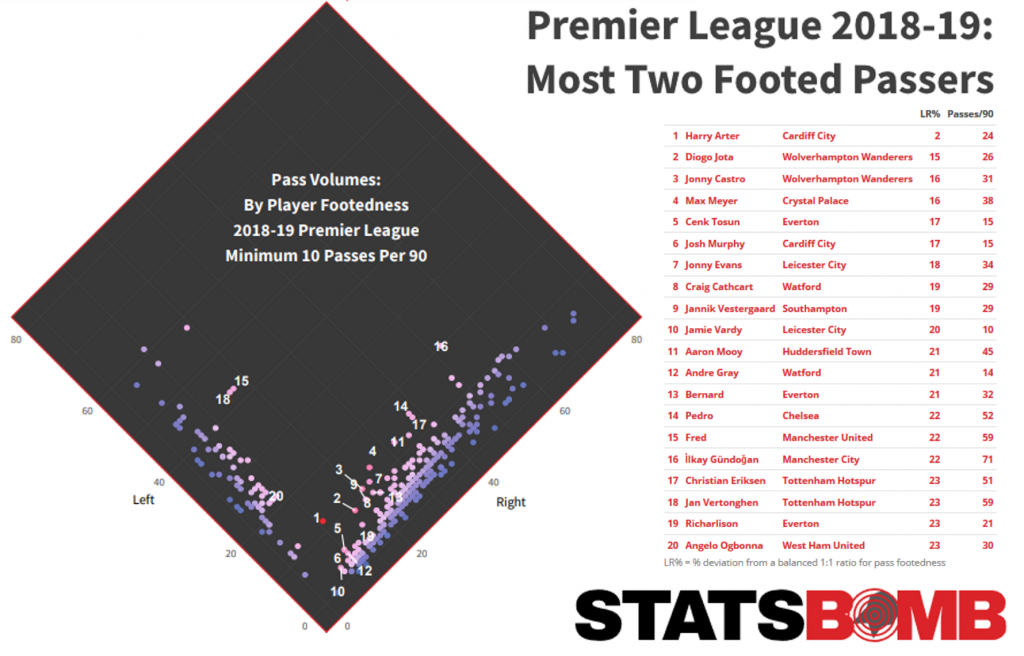
The solitary red dot is Arter, and you can see the rest of the top twenty most two footed passers highlighted within and listed adjacent. There are simply very few players who balance their passing output between feet, especially at high volumes and even for those that do here, there’s perhaps a skew towards those who spend time in mostly central positions, which is logical. İlkay Gündoğan is the highest volume passer in the top list, and as we can see here, his general profile skews strongly towards his favoured right foot:
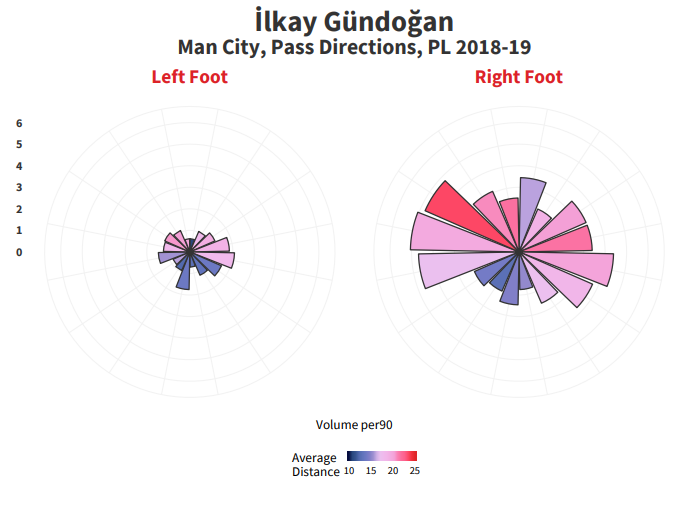
It's interesting to think of players in these terms though. Even if a player is using their off-foot infrequently, it still feels like a useful skill, if only to avert trouble. The player with the least diverse footedness profile this season is Arsenal's Shkodran Mustafi:
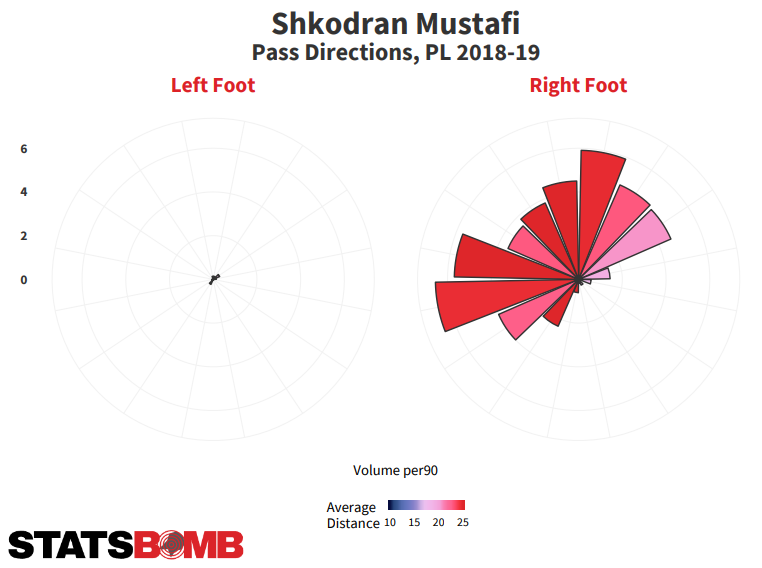
There's no 48 to 52 split for Mustafi, he literally attempts one left footed pass for every 48 right footed attempts. The features of his passing; often long and upfield, or to his left, and far less to his right, gives a window into his positioning in possession, Arsenal's use of a fairly high right full back, and perhaps a weakness, after all there are a limited set of directions Mustafi makes passes towards, and it will always be with his right foot.
Contrast quickly with Sokratis and Laurent Koscielny:
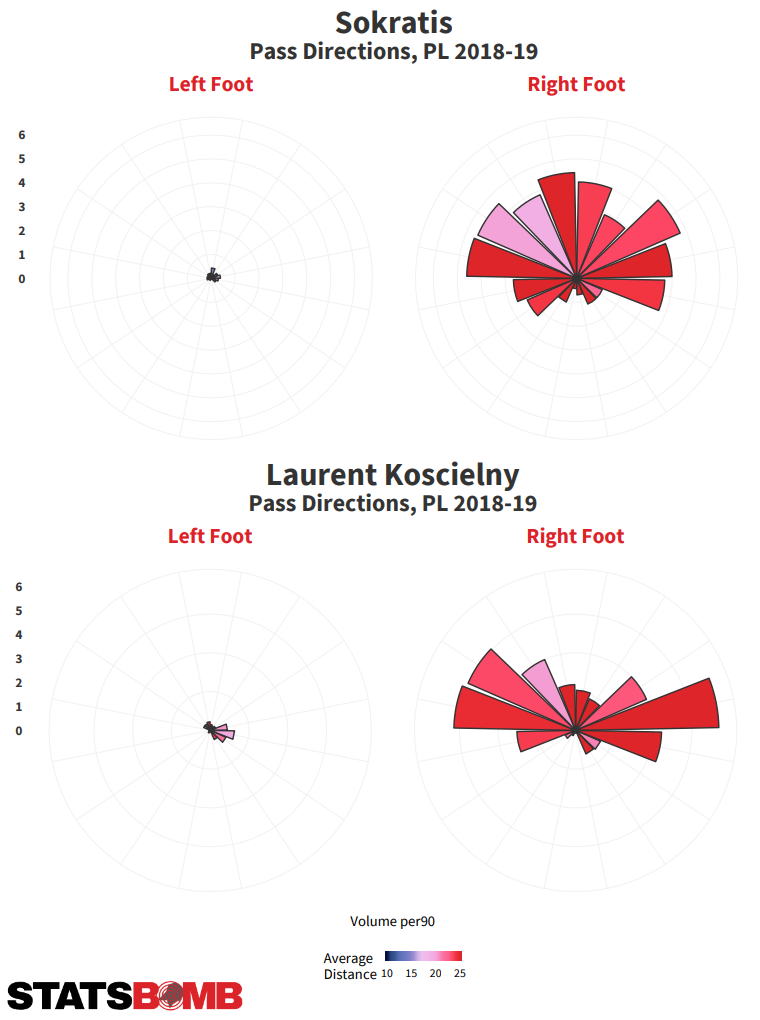
Each of Arsenal's three main centre backs are almost entirely right footed, but have different passing profiles. Koscielny looks to switch between his fellow defenders, from side to side, while Sokratis will pass forwards with range, left or right. Should an opponent run a press against Arsenal, and consider blocking passing lanes and preventing easy outs, there is information here to work with.
We've just touched the surface of ideas around pass footedness here, but hopefully it's given a flavour of how useful and informative it can be as a standard feature of a modern data specification. The reason why it helps as an aspect for pass modelling work or an input into recruitment analysis or opposition analysis: it scales. Every pass, in every game, in every league that StatsBomb collects holds body part information. Do remember too that StatsBomb has provided free data for women's football and the 2018 World Cup, so if your interest is piqued by some of the ideas enclosed here, there are datasets available for you to work on too.
Now i'm off to petition the PFA to correct their Team of the Year oversight and replace Paul Pogba with Harry Arter.